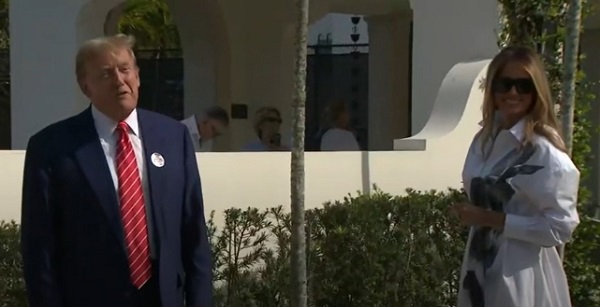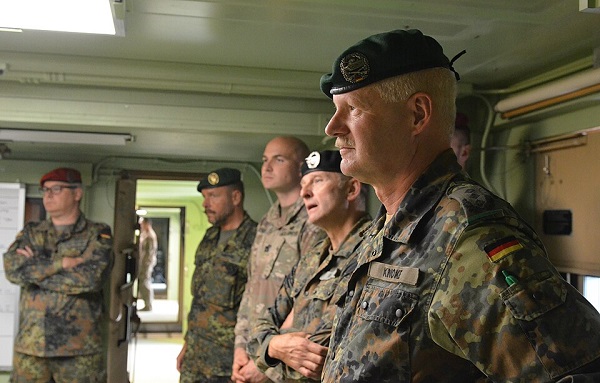Energy
Ontario Plans Major Nuclear Refurbishment to Meet Growing Electricity Demand

Pickering Nuclear Generating Station
From EnergyNow.ca
Ontario Power Generation planning to extend life of aging Pickering Nuclear Generating Station by decades
Ontario Power Generation is moving ahead with a plan to extend the life of the aging Pickering Nuclear Generating Station by decades, as the province tries to secure more electricity supply in the face of increasing demand.
Nuclear big player in getting to Net Zero
“Our province still needs this station and its workers,” he said at a press conference outside the nuclear plant. The construction phase will create about 11,000 jobs, he said, and provide about 6,000 jobs for decades.
OPG plans to spend $2 billion on engineering and design work and securing key components for the project that is expected to be completed in the mid-2030s.
Neither Smith nor OPG officials would give an estimate for how much the entire refurbishment will cost.
“It would be irresponsible at this point in time to put a number out there, because it’s this essential design and scoping and engineering work that is going to get us to the place where we can have a number,” Smith said.
OPG said a refurbishment at its Darlington Nuclear Generating Station is costing $12.8 billion and is on time and on budget.
Ken Hartwick, chief executive of OPG, said the Darlington refurbishment as well as one at Bruce Power will help guide the Pickering life extension.
“We have learned a lot about what it takes to refurbish a nuclear station the right way with thousands of lessons learned from Darlington and Bruce Power that we will apply to Pickering,” Hartwick said.
The four units produce about 2,000 megawatts of electricity, enough to power two million homes.
The Independent Electricity System Operator has said Ontario’s electricity demand is expected to grow by about two per cent each year, but could be even higher. A promise to build 1.5 million homes by 2031 and several large-scale manufacturing investments such as electric vehicle battery plants are helping to push demand higher.
The province needs more supply particularly starting in the mid-2030s, the IESO has said.
Keith Stewart, a senior energy strategist with Greenpeace Canada, said the price of wind and solar power with battery storage has “dropped like a stone” and should be more central to Ontario’s energy policy.
“Any credible independent cost-benefit analysis would find that we should be investing in the renewable-powered energy system of the future, rather than pouring billions more into rebuilding nuclear reactors long past their best-before date,” he wrote in a statement.
Pickering produces about 14 per cent of the province’s electricity but its current licence to operate the four units in question expires at the end of this year. OPG has asked the Canadian Nuclear Safety Commission to extend that to 2026, but a public hearing for that application has not yet been scheduled.
Green Party Leader Mike Schreiner said Greens understand that nuclear power will continue to be part of the energy mix for decades, but the province also needs much more wind and solar power and no more natural gas generation.
“Instead of attracting jobs and investment in low-cost renewables, the Ford government is making Ontario’s grid dirtier and more expensive by prioritizing dirty fossil gas plants and the costly, poor-performing Pickering plant,” he wrote in a statement.
The IESO announced last month that it is looking to add 2,000 megawatts of non-emitting electricity generation online such as wind, solar, bioenergy and hydro to the system. However, it also says natural gas is still required to ensure supply and stability in the short to medium term, though it will also increase greenhouse-gas emissions from the electricity sector.
Ontario’s electricity system was 94 per cent emissions free in 2020, but today that figure has fallen to 90 per cent.
The nuclear safety commission would still have to approve the Pickering refurbishment.
Two other units at Pickering are also set to stop operating at the end of this year. They are part of what’s known as the A units, which came online in the 1970s and were removed from service in 1997. Two of the units were refurbished and began operating again in 2003 and 2005.
Daily Caller
‘Drill, Baby, Drill’ Or $50 Oil — Trump Can’t Have Both


From the Daily Caller News Foundation
By David Blackmon
President Donald Trump has often made clear his goal of cutting prices for energy as part of his overall agenda to break the back of chronic inflation left behind by the Biden presidency. When talking about this goal, the president has placed special emphasis on lowering the price of crude oil, given its integral relationship to gas prices at the pump and transportation-related costs which go into the price of food, clothing and other consumer goods.
“A very big thing that I’m very happy with is oil is down,” Trump said in remarks in the Oval Office on Wednesday. “We’re getting that down. When energy comes down, prices are going to be coming down with it. So, in a very short period of time, we’ve done a very good job.”
White House advisor Peter Navarro has been quoted by The New York Times and other media outlets as saying that an average oil price of $50 per barrel would help tame inflation and set the stage for a return to a healthier economy. If that is indeed the goal, this week’s confluence of events, featuring a bigger-than-expected increase in oil production quotas from the OPEC+ oil cartel preceded less than 24 hours earlier by the president’s announced reciprocal tariffs on a wide array of countries went a long way to doing the trick.
Just prior to Trump’s tariff announcement Wednesday afternoon, the price for West Texas Intermediate crude stood at $70/bbl. Less than 48 hours later, the price had fallen below $61, a drop of about 15%. It was the largest 2-day decline in crude prices since 2021. How much of the price decrease is due to the tariffs as opposed to the OPEC+ agreement to pour another 137,000 barrels per day onto the international market is hard to know, but there is no doubt both actions had an impact.
As I’ve noted previously, this action to force lower prices for oil and natural gas lies directly at odds with the concurrent Trump “drill, baby, drill” objective which he sees as a key part of his American Energy Dominance agenda. The White House gave a nod to the oil refining segment in the Wednesday tariff announcement by exempting energy imports, another action at least in part aimed at lowering prices for gasoline and diesel fuel.
But that nod to the downstream segment does little for upstream companies who have seen supply chain muck-ups and Biden-era inflation raise break-even prices above Friday’s levels. The Q1 2025 Energy Survey Report published March 26 by the Dallas Federal Reserve estimates that drillers in the Permian Basin require a $61 oil price just to break even on drilling new shale wells. The needed breakeven price rises higher in other, less prolific basins. CNN quoted independent oil analyst Andy Lipow as saying that many upstream companies require prices closer to Monday’s $71/bbl level for new shale wells. It almost goes without saying that operators will have little incentive to “drill, baby, drill” if they stand to lose money doing it.
In an interview with Fox Business host Stu Varney on Tuesday, Energy Secretary Chris Wright, himself a former oil industry executive, said, “If your state has expensive energy, it’s because of choices made by politicians in those states to virtue signal somehow they’re on some global mission. They’re going to solve climate change by making your utility bills more expensive and your businesses want to relocate out of the states. That’s just nonsense.” He added that Trump was pursuing energy policies based on common sense, saying, “common sense will deliver more investment in our country and lower energy prices.”
No doubt, few executives in the industry would agree that a pursuit of $50 oil prices has anything to do with common sense for their companies. If prices should drop that far and linger there for any length of time, layoffs and idled drilling rigs will become the prevailing topic of the day in oil and gas.
So, while the White House might continue touting its “drill, baby, drill” slogan for the time being, we won’t hear it echoing through the barbecue and Tex-Mex joints in Midland, Texas, for the time being.
David Blackmon is an energy writer and consultant based in Texas. He spent 40 years in the oil and gas business, where he specialized in public policy and communications.
2025 Federal Election
Poilievre To Create ‘Canada First’ National Energy Corridor

From Conservative Party Communications
Poilievre will create the ‘Canada First’ National Energy Corridor to rapidly approve & build the infrastructure we need to end our energy dependence on America so we can stand up to Trump from a position of strength.
Conservative Leader Pierre Poilievre announced today he will create a ‘Canada First’ National Energy Corridor to fast-track approvals for transmission lines, railways, pipelines, and other critical infrastructure across Canada in a pre-approved transport corridor entirely within Canada, transporting our resources within Canada and to the world while bypassing the United States. It will bring billions of dollars of new investment into Canada’s economy, create powerful paycheques for Canadian workers, and restore our economic independence.
“After the Lost Liberal decade, Canada is poorer, weaker, and more dependent on the United States than ever before,” said Poilievre. “My ‘Canada First National Energy Corridor’ will enable us to quickly build the infrastructure we need to strengthen our country so we can stand on our own two feet and stand up to the Americans.”
In the corridor, all levels of government will provide legally binding commitments to approve projects. This means investors will no longer face the endless regulatory limbo that has made Canadians poorer. First Nations will be involved from the outset, ensuring that economic benefits flow directly to them and that their approval is secured before any money is spent.
Between 2015 and 2020, Canada cancelled 16 major energy projects, resulting in a $176 billion hit to our economy. The Liberals killed the Energy East pipeline and passed Bill C-69, the “No-New-Pipelines” law, which makes it all but impossible to build the pipelines and energy infrastructure we need to strengthen the Canadian economy. And now, the PBO projects that the ‘Carney cap’ on Canadian energy will reduce oil and gas production by nearly 5%, slash GDP by $20.5 billion annually, and eliminate 54,400 full-time jobs by 2032. An average mine opening lead time is now nearly 18 years—23% longer than Australia and 38% longer than the US. As a result of the Lost Liberal Decade, Canada now ranks 23rd in the World Bank’s Ease of Doing Business Index for 2024, a seven-place drop since 2015.
“In 2024, Canada exported 98% of its crude oil to the United States. This leaves us too dependent on the Americans,” said Poilievre. “Our Canada First National Energy Corridor will get us out from under America’s thumb and enable us to build the infrastructure we need to sell our natural resources to new markets, bring home jobs and dollars, and make us sovereign and self-reliant to stand up to Trump from a position of strength.”
Mark Carney’s economic advice to Justin Trudeau made Canada weaker while he and his rich friends made out like bandits. While he advised Trudeau to cancel Canadian energy projects, his own company spent billions on pipelines in South America and the Middle East. And unlike our competitors Australia and America, which work with builders to get projects approved, Mark Carney and Steven Guilbeault’s radical “keep-it-in-the-ground” ideology has blocked development, killed jobs, and left Canada dependent on foreign imports.
“The choice is clear: a fourth Liberal term that will keep our resources in the ground and keep us weak and vulnerable to Trump’s threats, or a strong new Conservative government that will approve projects, build an economic fortress, bring jobs and dollars home, and put Canada First—For a Change.”
-

 2025 Federal Election1 day ago
2025 Federal Election1 day agoCanada Continues to Miss LNG Opportunities: Why the World Needs Our LNG – and We’re Not Ready
-

 International16 hours ago
International16 hours agoGermany launches first permanent foreign troop deployment since WW2
-

 2025 Federal Election1 day ago
2025 Federal Election1 day agoMainstream Media Election Coverage: If the Election Was a NHL Game, the Ice Would be Constantly Tilted Up and to the Left
-

 2025 Federal Election19 hours ago
2025 Federal Election19 hours agoPoilievre To Create ‘Canada First’ National Energy Corridor
-

 International1 day ago
International1 day agoFREE MARINE LE PEN!’: Trump defends French populist against ‘lawfare’ charges
-

 COVID-1915 hours ago
COVID-1915 hours agoMaxime Bernier slams Freedom Convoy leaders’ guilty verdict, calls Canada’s justice system ‘corrupt’
-

 Health2 days ago
Health2 days agoSelective reporting on measles outbreaks is a globalist smear campaign against Trump administration.
-

 Automotive2 days ago
Automotive2 days agoAuto giant shuts down foreign plants as Trump moves to protect U.S. industry






